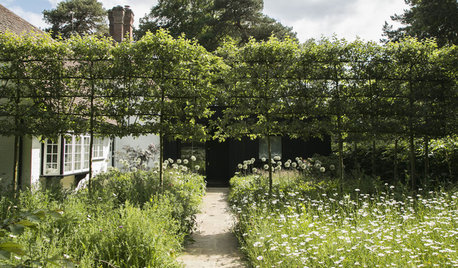disease resistant apples vs. insects
cousinfloyd
9 years ago
Related Stories

GARDENING GUIDESTree Care: Common Tree Diseases and What to Do About Them
Learn to recognize trees that may be affected by diseases or pests so you can quickly take action
Full Story
GARDENING GUIDESOrganic Matters: Thwart Insect Pests With Trap Crops
Add a few sacrificial plants to your garden to lure insects away from the harvest
Full Story
TREES7 Deer-Resistant Flowering Trees to Plant this Fall
If you live in a neighborhood with roaming deer, consider these beautiful trees that won't tempt hungry guests
Full Story
EDIBLE GARDENSHow to Add an Apple Tree to Your Edible Garden
Readily available, beautiful and fragrant, apple trees offer four-season interest along with crisp, juicy fruit
Full Story
GARDENING GUIDES10 Deer-Resistant Native Flowers to Plant This Fall
Learn about natives that embrace some kinds of wildlife but resist grazing deer
Full Story
GARDENING GUIDESTop 12 Summer-Blooming Perennials for Deer-Resistant Drama
Can you have garden color, fragrance and exciting foliage with hungry deer afoot? These beauties say yes
Full Story
GARDENING GUIDESGreat Design Plant: Rosa Banksiae a Low-Maintenance Beauty
This thornless, disease- and insect-resistant rose brings showers of white or yellow flowers to the spring garden
Full Story
GARDENING AND LANDSCAPINGCrab Apple Trees Set Off a Stylish English Courtyard
A structure of pleached crab apple trees, bordered by a wildflower meadow, links a minimalist addition to an old house in Buckinghamshire
Full Story
GARDENING FOR BUTTERFLIESGarden for Wildlife to Reap Rich Rewards
When you plant with animals and insects in mind, you make gardening easier, the planet healthier and yourself more present
Full Story
GARDENING FOR BUTTERFLIESGardening for the Bees, and Why It’s a Good Thing
When you discover how hard bees work for our food supply, you may never garden without them in mind again
Full StoryMore Discussions




Scott F Smith
drew51 SE MI Z5b/6a
Related Professionals
Fillmore Landscape Architects & Landscape Designers · Salem Landscape Architects & Landscape Designers · Bellefontaine Neighbors Landscape Contractors · Brandon Landscape Contractors · Brooklyn Park Landscape Contractors · Chelmsford Landscape Contractors · Commack Landscape Contractors · Live Oak Landscape Contractors · Long Beach Landscape Contractors · Longview Landscape Contractors · Melrose Park Landscape Contractors · Severna Park Landscape Contractors · Stallings Landscape Contractors · West Covina Landscape Contractors · Ferguson Landscape Contractorsmaryhawkins99
Chris-7b-GA
marknmt
bob_z6
bonnan
Scott F Smith
cousinfloydOriginal Author
Scott F Smith
applenut_gw
clarkinks
appleseed70
alan haigh
Scott F Smith
bob_z6
olpea
Scott F Smith
cousinfloydOriginal Author
drew51 SE MI Z5b/6a
olpea
appleseed70
alan haigh
olpea
appleseed70
alan haigh
cousinfloydOriginal Author
applenut_gw
alan haigh
spartan-apple
Scott F Smith
applenut_gw
alan haigh
applenut_gw
spartan-apple
applenut_gw
Scott F Smith
alan haigh
bob_z6
cousinfloydOriginal Author
maryhawkins99
applenut_gw
Andrew Trueman